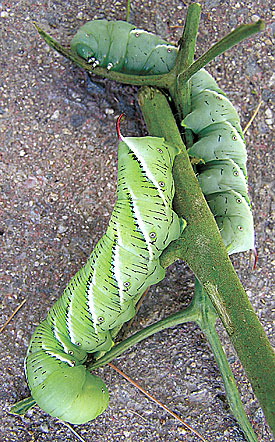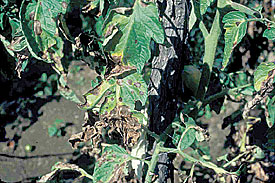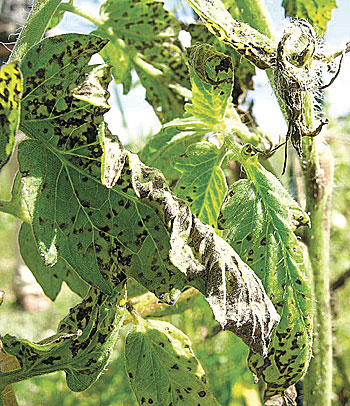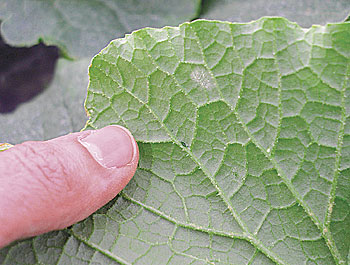Does summertime bode many afternoon hours in the hammock thinking about what’s good in the garden to go with that hamburger hot off the grill – or hours of worrying what could go wrong in that garden, which looks so good this early in the season? Balancing fun with fret is key to a long life and a good garden. Knowing about and preparing for common problems that could decimate favorite crops is one way to minimize the fretting.
By now the worst of the spring pests – cutworms, flea beetles, cucumber beetles and potato beetles – should be in the past. Here are some tips for dealing with summertime pests.
 |
| Handpick hornworms to control them – if you are very observant and diligent. Otherwise, apply a Bt insecticide. English photo. |
Hornworms
Hornworms are probably the most destructive insect on tomatoes. These giant caterpillars can eat a vast amount very quickly, sometimes almost stripping a healthy looking tomato plant of its foliage overnight, leaving only bare stems. Hornworms also attack fruit, chewing gouges so large that they look more like bites of a furry animal rather than an insect. Watch for hornworm damage and frass (excrement) – black pellets lying around hornworm host plants. Frass may be the first sign of a problem.
Adult hornworms are large, fast flying hawk moths, which in flight may look like a hummingbird. At dusk they hover over flowers, sucking nectar. Their eggs, laid on tomato leaves, hatch in five days.
Picking hornworms off plants by hand is a bit frightening but does work, and chickens enjoy fighting with the challenging pest. The problem with hand picking is that the leaf-colored caterpillar blends with foliage so well that you can easily overlook one or two caterpillars, which can do significant damage in a day or two.
The Bt insecticide works well against these caterpillars, especially when they are small. The Dipel 2X brand of Bt is common in good gardening centers.
What Are Those White Things on the Tomato Hornworms?
A number of insects parasitize tomato hornworm larvae (caterpillars). A small braconid wasp, Cotesia congregatus, is one of the most common. The wasp eggs laid on the hornworm hatch into larvae, which feed on the inside of the hornworm until the wasp is ready to pupate. The cocoons are small white projections protruding from the hornworm’s body. Leave parasitized hornworms in the field to conserve the beneficial parasitoids. When the wasps emerge from their cocoons, they’ll kill their host hornworms and will seek other hornworms to parasitize.
Tomato Spots
 |
| Early blight |
 |
| Septoria leaf spot on tomatoes. Eric Sideman photo. |
The most common diseases on tomatoes grown in gardens in Maine are early blight, bacterial spot and bacterial speck, and Septoria leaf spot.
Bacterial speck starts as dark brown to black spots on leaves. The spots later develop yellow halos around the affected area. On the fruit, black specks rarely get larger than 1 mm. Bacterial spot starts as brownish, circular spots that may become irregular and as large as 3 mm. These diseases may be seed borne and may be carried over in weeds. High humidity and low temperatures favor bacterial speck.
Early blight, caused by a fungus, starts on the lower leaves as small, circular, concentric spots that look like targets. As the leaves develop, the spots enlarge and develop yellow, blighted areas. Later the tomato fruit may rot on the stem end. The disease is carried on tomato residue in the soil and on seed.
Septoria leaf spot is a fungal disease that starts on the lower leaves as spots with dark brown margins and tan centers. The spots do not look like targets. This disease, which can cause rapid defoliation, is carried on tomato residue in the soil and on seed.
Crop rotation is the first line of defense against these problems. Sanitation is important. Do not grow tomatoes near cull piles of last year’s crops. Trellising, staking, cages, etc., help by getting plants off the ground, but remember to disinfect structures that were used last year. (A 12X dilution of household bleach works.) If you did not use these important practices this year, you can still prune off diseased lower leaves. With bacterial diseases, be sure to disinfect tools after pruning. Avoid working in the crops when they are wet. Scouting is important. If the season is wet, start scouting early. If you decide to use a fungicide to fight these diseases, copper is probably the most effective one for organic growers. Start spraying copper at the first sign of problems, and keep new tissue covered. Champ WG is an approved formulation for commercial organic growers.
Potato Leafhoppers
Potato leafhoppers (PLH) make it to Maine almost every year. Some years their numbers are so low that they’re unnoticed; other years their numbers are so high that crops die midseason. PLH are likely to be found in potatoes, beans, strawberries and alfalfa. PLH overwinter in the South and leapfrog north in mass migrations. Females arrive first, usually carrying fertilized eggs. Then a few generations occur during the growing season before the cold north winter kills the insects.
Leafhopper damage is catastrophic. The bug sucks the juice from plants and injects a toxin that clogs the food-conducting tissue. After a while, symptoms look like a disease rather than insect damage. The leaves first get pale, then yellow, then brown from the edges (“hopper burn”). Then the plant dies.
The adult PLH is light green, wedge shaped and tiny (1/8-inch long). To check for PLH, brush plants to see if any bugs jump. The nymphs are similar to the adults but have no wings, are smaller and live on the underside of the leaves. When disturbed, a nymph will run – and it can run sideways as fast as forward. This is a clue that you have PLH and not some other, less harmful leafhopper.
The adults are flighty. When you brush your crop, they’ll fly up. If you see a cloud of leafhoppers, you’re in trouble. If you see only one or two in a row of plants, your crop probably will not be hurt badly. That is why researchers have developed a threshold below which treatment is not recommended. For example, you don’t have to spray an insecticide on beans until the PLH population equals or exceeds a mean of one nymph per leaf or 50 adults per 10 sweeps with an insect net.
Crop rotation does not counter this pest, since it comes from far away each year. Row covers would work, but these crops are not the types that are usually covered. Effective insecticides are limited. The only material that I have seen work and that is allowed in organic production is pyrethrum, so I recommend Pyganic for commercial growers.
Imported Cabbage Worm
The imported cabbage worm is the caterpillar of the white butterflies flying around cabbage family plants. The butterflies are laying eggs now, and the larvae (green caterpillars) are chewing holes in leaves. If you have heading broccoli, you may want to search for the caterpillar, because some folks are really turned off by seeing the critters float to the top of the water in the cooking pot. You may want to spray even though the crop is beyond risk.
This pest overwinters as pupae and has three to four generations per year, so once you start seeing the butterfly, scout for the caterpillar in about a week. Bt (Dipel 2X or Dipel DF) controls the caterpillar well but does not last long in the field, so spray only when the caterpillar population is large enough to warrant it. Row covers also work but are much more expensive.
Destroy or bury crop residue after harvest to prevent the caterpillars from continuing to feed and complete their life cycle and thus produce a larger second generation.
 |
| Powdery mildew on cucurbits. Eric Sideman photo. |
Powdery Mildew
Powdery mildew is a common disease of pumpkins and winter squash. All cucurbits are susceptible, but many common cucumber and melon varieties are resistant. The disease can cause infected leaves to die prematurely, reducing yields and lowering fruit quality, especially taste. Winter squash from diseased plants won’t store as long as fruits from healthy plants. The fungus that causes the disease does not overwinter in Maine. Spores blow up every year from southern overwintering sites. If they arrive late in the season, you may not need any control; but if they arrive in early to midsummer, exercise some control or you may have no leaves by mid-August.
Check upper and lower surfaces of leaves of older plants every few days starting now. The first symptoms usually are white, powdery fungal patches on the undersides of older leaves. Yellow spots may form opposite these, on the upper leaf surfaces.
No products with systemic activity (products that move through the plant) are approved for organic production, and applying fungicide to the lower leaf surface is difficult. In experiments, foliar applications of sulfur have been more effective than most other organic products for powdery mildew on lower surfaces, apparently because sulfur deposited on the upper leaf surface can volatilize and be redistributed to the lower surface. Sulfur can be phytotoxic on melons, especially if applied when temperatures are hot.
ATTRA (National Sustainable Agriculture Information Service, www.attra.ncat.org) reports that a single spray application (to runoff) of 0.5 percent (wt./vol. of water) baking soda, plus 0.5 percent (vol./vol. of water) SunSpray UFP® horticultural oil almost completely inhibited powdery mildew on heavily infected pumpkin foliage; while baking soda without the oil was ineffective, and a 2 percent (wt./vol. of water) solution of baking soda damaged the leaves.
Eric Sideman is MOFGA’s organic crop specialist. You can contact him at 568-4142 or [email protected] with your farming or gardening questions.
